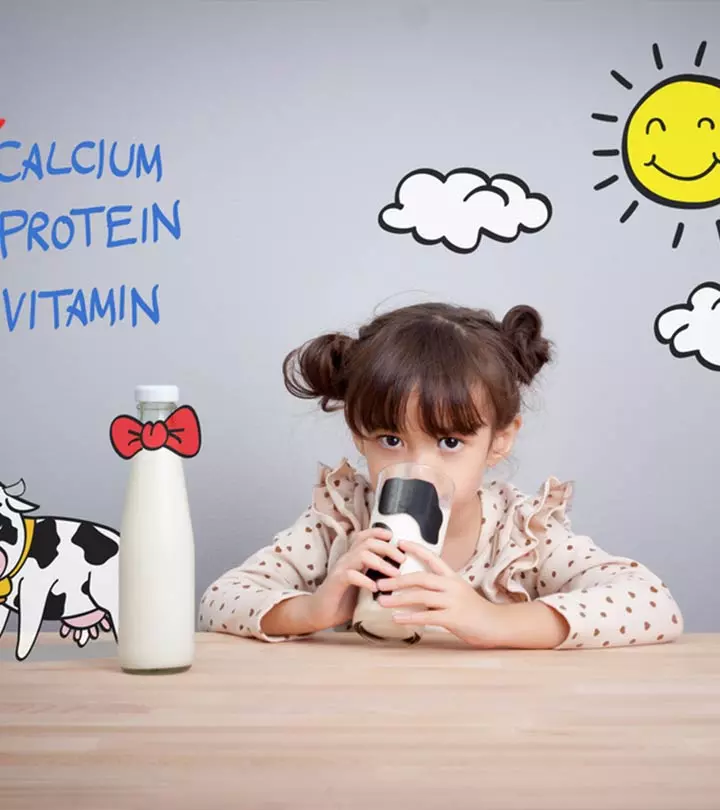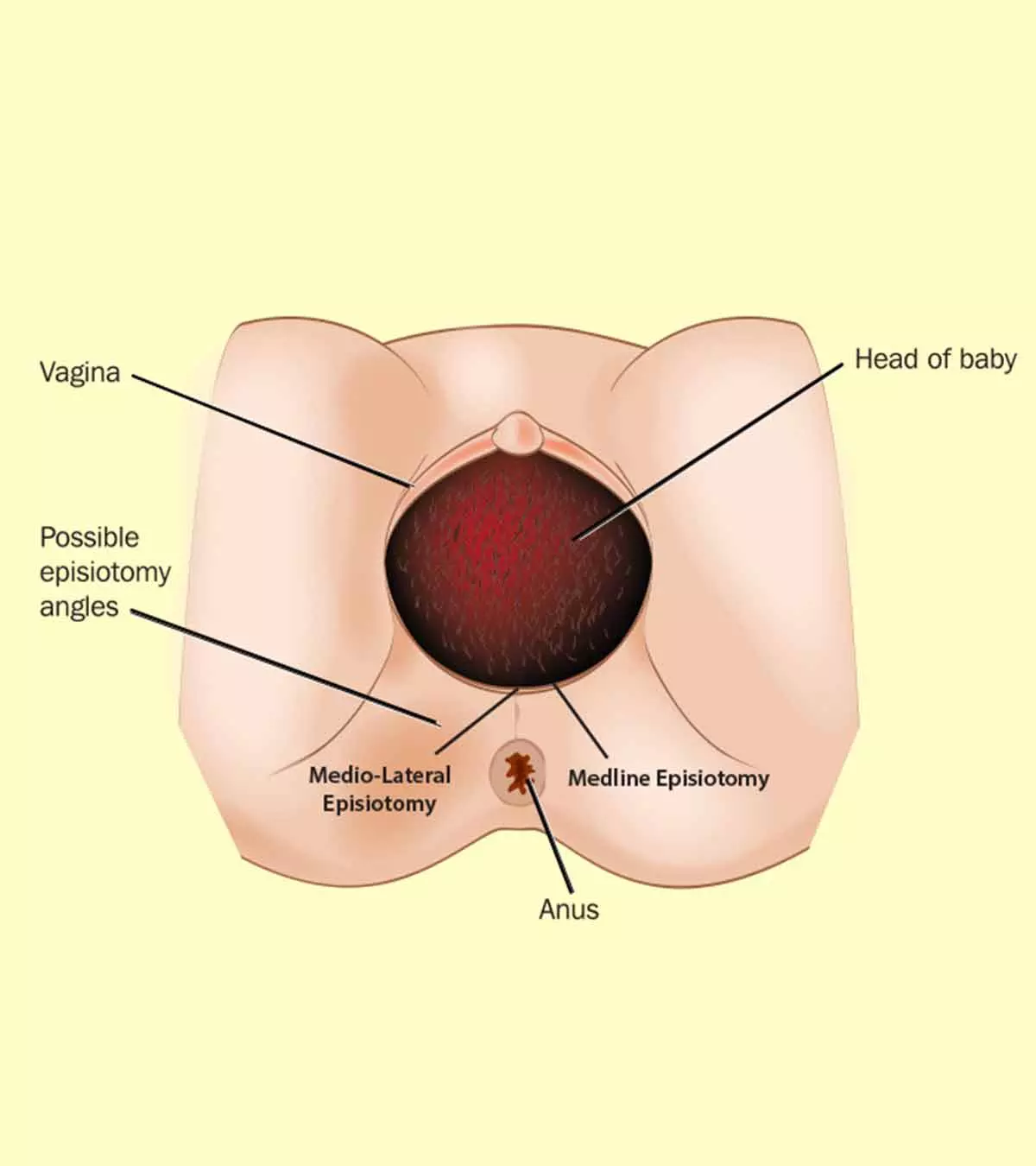

Image: Shutterstock

Calcium is an essential mineral for all ages. The benefits of calcium for kids include the development of strong bones and teeth. This mineral is available in several food sources, such as fortified cereals, dairy products, and certain vegetables.
If children do not get sufficient calcium for a long period, they may develop calcium deficiency, leading to issues such as nutritional rickets. These children may require calcium supplementation to optimize the calcium levels in their bodies.
Read this post to understand why your child needs calcium, how much their daily requirement is, the best food sources for calcium, and when calcium supplementation should be considered.
Why Do Children Need Calcium?
About 99 percent of the calcium in the body is stored in bones and teeth, and the remaining is found in the nerve cells, body tissues, blood, and other body fluids (1). Besides maintaining the health of bones and teeth, calcium helps with (2).
- Contraction and relaxation of muscles
- Widening of blood vessels (vasodilation)
- Sending and receiving nerve signals (nerve transmission)
- Hormone secretion
- Blood clotting
- Maintaining a normal heartbeat
The body needs daily calcium intake in recommended amounts to propel these functions smoothly. The next section deals with daily calcium intake recommendations for children.
How Much Calcium Do Children Need?
A child’s calcium needs depend on their age. Here’s the age-specific recommended dietary allowance (RDA) of calcium for children and teens aged two to 18 years (3).
| Age (years) | RDA (mg per day) |
|---|---|
| 2 to 3 | 700 |
| 4 to 8 | 1000 |
| 9 to 13 | 1300 |
| 14 to 18 | 1300 |
Source: Dietary Guidelines For Americans 2025-2025
In addition to ensuring optimum calcium intake, you should pay special attention to your child’s vitamin D intake. Vitamin D is essential for calcium absorption.
Food Sources Of Calcium
Below is the list of different food sources of calcium that you can incorporate into your child’s diet to meet their nutritional needs.
1. Dairy products
Milk and milk-based foods such as cheese, yogurt, cottage cheese, and buttermilk are rich sources of calcium. Here’s a peek into how much calcium different milk products can offer (1).
| Foods | Calcium per serving (mg) |
|---|---|
| Yogurt—plain, low fat (8oz) | 415 |
| Mozzarella—partly skimmed (1.5oz) | 313 |
| Milk—nonfat, (1 cup)* | 299 |
| Milk—reduced-fat (2% milkfat), (1 cup) | 293 |
| Milk, buttermilk—low-fat (1 cup) | 284 |
| Cottage cheese—1% milkfat (1 cup_ | 138 |
Source: National Institute Of Health
*Calcium content varies slightly by fat content; the more fat in the food, the less calcium it contains. So, choose low-fat dairy and its products for your child and teen.
2. Vegetables
Vegetables aren’t the richest source of calcium, but some veggies can contribute to meeting your child’s daily dietary calcium requirements. For instance, dark green, leafy vegetables, such as broccoli, kale, and spinach, are good calcium sources for those who abstain from consuming milk and milk products (vegans or lactose intolerant people).
Here’s a list of veggies and other plant-based foods, such as seeds, with the amount of calcium they can provide per serving (1).
| Foods | Calcium per serving (mg) |
|---|---|
| Turnip greens—fresh, boiled (½ cup) | 99 |
| Kale—fresh, cooked (1 cup) | 94 |
| Chinese cabbage (bok choy)—raw, shredded (1 cup) | 74 |
| Broccoli—raw (½ cup) | 21 |
| Chia seeds (1 tablespoon) | 76 |
Source: National Institute Of Health
3. Calcium-fortified foods
Calcium-fortified foods are those that have been enriched with calcium during their processing. Some of the calcium-fortified foods that can give a good amount of calcium to children and teens are
| Foods | Calcium per serving (mg) |
|---|---|
| Calcium-fortified orange juice (1 cup) | 349 |
| Calcium-fortified soymilk (1 cup) | 299 |
| Breakfast cereals, fortified with 10% of the daily value (DV) for calcium (1 serving) | 130 |
Source: National Institute Of Health
Besides these, sardines and salmon with bones and tofu processed with calcium salt are good calcium sources.
Note: Calcium content in processed foods can vary depending on the source of calcium. For instance, certain types of cheese made with goat’s milk, an excellent calcium source, can have more calcium than other types. Therefore, read the nutrition labels and ingredient list of packaged foods carefully.
Calcium Supplementation
Most healthy children who eat a well-balanced diet containing foods from different food groups meet their calcium requirements. However, if a child is a picky eater, follows a vegan-style eating pattern, or has a medical issue that affects calcium absorption, they may have low calcium levels. In such cases, discussing calcium supplementation with the doctor is advisable.
Your doctor can prescribe your child multivitamins and multi-minerals containing calcium or standalone calcium dietary supplements that often contain vitamin D as well (4). These supplements are available as tablets, capsules, powder, and gummies. Typically, calcium supplements are available in two forms—carbonate and citrate.
- Calcium carbonate is an inexpensive form of calcium that is best absorbed when consumed with food. Each pill or tablet of calcium supplement containing calcium carbonate offers 200 to 400mg of calcium.
- Calcium citrate is a more expensive form of calcium absorbed well on both a full stomach and an empty stomach. Children with low stomach acid levels can be given calcium citrate.
Besides these, some other forms of calcium found in supplements and foods include calcium gluconate, calcium lactate, and calcium phosphate.
“In general, it is recommended that children obtain most of their calcium from natural food sources. However, if high calcium foods are not readily accepted, then supplements may be helpful. Be sure to check the standard multivitamins you’re considering because most of them will be very low in calcium due to the chemical properties of the nutrients in the vitamins. Typically it’s helpful to do calcium plus vitamin D option,” says pediatric dietitian and founder of Feeding Bliss, Courtney Bliss.
Note: Calcium supplements may cause gas, bloating, and constipation in sensitive children and teens. If your child experiences these symptoms, try dividing the total dose into mini doses and serve them throughout the day. Alternatively, you can consult your healthcare provider and look for some other calcium brands.
Tips To Get Calcium From Diet
Here are some useful tips to ensure your child gets enough calcium from different foods.
- Include at least one calcium-rich food in every meal you serve to your child. “Aim for two to three servings of calcium each day. Some families find it helpful to have almost like a meal routine for serving. For example, I know each breakfast and afternoon snack will have a high calcium item. That way, it’s basically on autopilot!” shares Bliss.
Dairy products, seeds, egg yolk, fish with bones, fortified soy products, and cereals are good calcium sources you can try. You may use these foods to prepare different types of healthy yet flavorful meals.
Here are some meal ideas that you can try using different calcium-rich foods.
- Replace peanut butter with almond butter in a whole wheat sandwich.
- Add fruits to unsweetened, low-fat Greek yogurt.
- Prepare smoothies using fruits, yogurt, low-fat milk, or fortified soy milk.
- Sprinkle low-fat cheese on pasta or vegetable salad.
- Serve stir-fried tofu with edamame hummus.
- Give three portions of dairy to your child every day. According to the Dietary Guidelines For Americans 2025-2025, children aged two years and above consuming 2000kcal a day should consume three cups equivalent of dairy per day (3) Since dairy products contain both calcium and vitamin D, feeding them to children is a good choice, provided they aren’t vegan or have a milk allergy or lactose intolerance.
- Offer your child plenty of grains. Although they aren’t rich in calcium, grains can contribute to your child or teen’s daily needs (4).
- Buy calcium-fortified foods that also contain vitamin D for better calcium absorption. Look for foods that can offer 20 to 30 percent of calcium as such products are excellent calcium sources for your child’s diet (5).
- Cook foods in just enough water so that they cook faster and retain more calcium (2). Sauteing and steaming food are the best cooking methods to retain calcium in the food.
- Avoid serving excess high-fiber foods such as wheat bran and green leafy veggies (spinach and rhubarb). This is crucial as green leafy veggies contain antinutrients, such as oxalic acid that interfere in calcium absorption (2). Thus, it reduces the bioavailability of calcium.
Frequently Asked Questions
1. How much calcium is too much for a child?
The National Institutes of Health, US, has provided daily upper limits for dietary intake of calcium based on age. For children, they are (4):
- Children one to eight years: 2,500mg
- Children 9 to 18 years : 3,000mg
Any dose above these limits can be considered too much for a child.
2. How do I know if my child has calcium deficiency?
Symptoms of low calcium levels in children may include dry skin, dry hair, brittleness of nails, weak tooth enamel, muscle cramps, and tingling in the fingers and toes (6).
3. Can taking too much calcium be harmful to kids?
Some scientific studies suggest that excessive calcium intake may cause an increased risk of heart disease. Though high blood and urine calcium levels are usually caused due to underlying pathologies (such as high parathyroid hormone levels) rather than high calcium in diet, it may affect muscle tone and kidney functions and cause fatigue, nausea, abnormal heart rhythm and weight loss (4).
The requirements of nutrients and minerals may differ depending on your children’s age for healthy growth. Therefore, while including calcium for kids, ensure to stick to the recommended amount. Calcium is a necessary mineral, and children need it for strong bone and teeth development. So include calcium-rich food in their diet and vitamin D to help their body absorb the calcium. Before opting for a calcium supplement, consult their doctor to know the correct dosage and safety.
Key Pointers
- Calcium is vital for the development of strong bones and teeth.
- A child’s calcium needs vary depending on their age.
- Dairy products and vegetables like broccoli, and spinach are good sources of calcium.
- Consider calcium supplementation for your child, if they are a picky-eater, after consultation with a doctor.
References
- Calcium Fact Sheet for Health Professionals.
https://ods.od.nih.gov/factsheets/Calcium-HealthProfessional/ - Calcium in diet
https://medlineplus.gov/ency/article/002412.htm - Dietary Guidelines for Americans 2025-2025.
https://www.dietaryguidelines.gov/sites/default/files/2025-12/Dietary_Guidelines_for_Americans_2020-2025.pdf - Calcium Fact Sheet for Consumers.
https://ods.od.nih.gov/factsheets/Calcium-Consumer/ - A Food Labeling Guide.
https://www.fda.gov/files/food/published/Food-Labeling-Guide-%28PDF%29.pdf - Hypocalcemia in Children.
https://www.hopkinsmedicine.org/health/conditions-and-diseases/hypocalcemia-in-children
Community Experiences
Join the conversation and become a part of our nurturing community! Share your stories, experiences, and insights to connect with fellow parents.
Read full bio of Maria Carmela Villania-Mamauag
Read full bio of Swati Patwal














